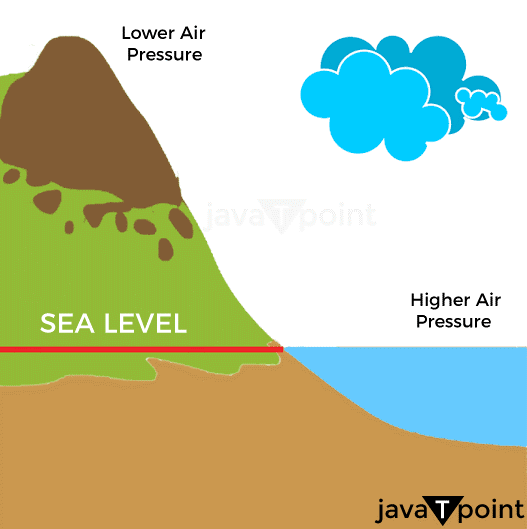Atmospheric Pressure DefinitionWhen we gaze up, we see a lovely blue sky, fluffy white clouds during the day and a starry sky during the night. However, there is something significant that we are unable to see: the atmosphere, a dense layer of gases that surrounds the Earth. This layer of gases plays a critical part in our weather and climate as well as shielding us from the destructive rays coming from the sun. The force that the atmosphere exerts on the Earth's surface by its weight is called atmospheric pressure. Atmospheric pressure is a fundamental concept in the study of meteorology. It influences a wide range of weather patterns and is responsible for the development of high- and low-pressure systems that drive the movement of air masses across the planet. Understanding atmospheric pressure is crucial for predicting weather and climate changes, as well as for aviation and space travel. In this article, we'll learn more about atmospheric pressure, how it works, and why it matters for our planet. What is Atmospheric Pressure?Atmospheric pressure is the force that is exerted by the weight of the atmosphere on the surface of the Earth and objects within it. The weight of the air molecules in the atmosphere creates a force that pushes down on everything below it, including people, buildings, and the surface of the Earth itself. At the sea level, the average atmospheric pressure is about 101.3 kilopascals (kPa), which is also referred to as one atmosphere (atm) of pressure. This pressure decreases with an increase in altitude since there are fewer air molecules higher up in the atmosphere. Atmospheric pressure is an important factor in weather patterns, as changes in pressure can indicate the movement of air masses and the formation of storms. The health of people can also be impacted by atmospheric pressure in addition to the environment. Headaches, light-headedness, and weariness can be brought on by low-pressure systems, such as those that develop during a storm or typhoon. On the other hand, high-pressure systems can make breathing problems like asthma and chronic obstructive pulmonary disease (COPD) worse. It is also an important consideration in aviation and scuba diving since changes in pressure can affect human physiology and equipment performance. 
Factors Affecting Atmospheric PressureVarious factors impact atmospheric pressure, and among them, the most important are altitude, temperature, and moisture content present in the air.
Unit of Measurement of Atmospheric PressureUsually, we use many different units to measure atmospheric pressure. The most prevalent among these are pascals (Pa), millimetres of mercury (mmHg), and pounds per square inch (psi).
Applications of Atmospheric PressureAtmospheric pressure has several practical applications in various fields, including weather forecasting, aviation, scuba diving, and medical treatments. These applications are discussed in detail below:
Historical ContextHumans were aware of the concept of atmospheric pressure for centuries, but it was only in the 1600s, that atmospheric pressure was accurately defined and measured for the first time. One of the earliest recorded observations was made by the Greek philosopher Aristotle, who noted that the air had weight and that this weight could cause changes in the weather. However, it wasn't until the invention of the barometer that atmospheric pressure could be accurately measured. In 1643, Evangelista Torricelli, a famous Italian mathematician and physicist, invented the barometer. He used a glass tube, filled it with mercury and inverted it into a bowl also filled with mercury. Thus making a vacuum at the top of a glass tube. The weight of the atmosphere pressing down on the bowl pushed the mercury up the tube to a height of about 760 millimeters, which is the standard atmospheric pressure at sea level. This invention revolutionized the field of meteorology and allowed for more accurate weather predictions. To show him respect for his work, we use Torr as a unit of pressure. 1 Torr is equivalent to 1760 standard atmospheres (101325 Pa). 
Recent DevelopmentsTo understand atmospheric pressure and how it affects weather and climate, the study is being conducted continuously. The drone used to gauge air pressure in far-off places is one area of focus. Particularly in difficult-to-reach areas where traditional weather stations are not practical, drones fitted with sensors can gather crucial data about the dynamics of the atmosphere. In hilly areas, for instance, researchers have discovered that drones are a useful tool for capturing atmospheric data. The creation of new weather forecasting models that take atmospheric pressure information into account is another significant research field. These models more correctly simulate the behaviour of the atmosphere by utilising cutting-edge algorithms and data assimilation methods. The Integrated Forecasting System (IFS), a cutting-edge weather forecasting model created by the European Centre for Medium-Range Weather Forecasts (ECMWF), combines data from numerous sources to generate extremely precise weather forecasts up to ten days in advance. New weather forecasting models that incorporate information on atmospheric pressure are also being developed by other organisations, such as the National Oceanic and Atmospheric Administration (NOAA). Enhancing our capacity to anticipate and respond to extreme weather occurrences will allow us to save lives and lessen the economic impact. These studies aim to enhance our capacity for anticipating and responding to extreme weather occurrences, ultimately saving lives and lessening the financial toll of severe weather. ConclusionIn conclusion, atmospheric pressure is a fundamental concept in the study of meteorology, influencing weather patterns and playing a critical role in the development of high- and low-pressure systems that drive the movement of air masses across the planet. Understanding atmospheric pressure is crucial for predicting weather and climate changes, as well as for aviation and space travel. Factors affecting atmospheric pressure include altitude, temperature, and moisture content present in the air. Atmospheric pressure is measured using various units, including pascals, millimeters of mercury, and pounds per square inch. It has practical applications in various fields, including weather forecasting, aviation, scuba diving, and medical treatments.
Next TopicAtomic Radius Definition
|
 For Videos Join Our Youtube Channel: Join Now
For Videos Join Our Youtube Channel: Join Now
Feedback
- Send your Feedback to [email protected]
Help Others, Please Share










